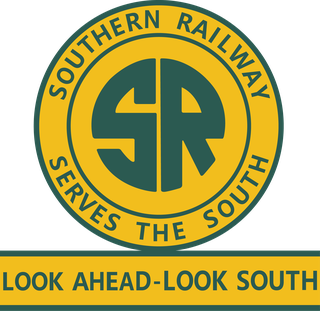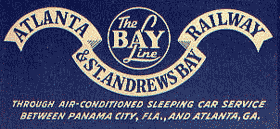
The Southern Railway was a class 1 railroad based in the Southern United States between 1894 and 1982, when it merged with the Norfolk & Western to form Norfolk Southern. The railroad was the product of nearly 150 predecessor lines that were combined, reorganized and recombined beginning in the 1830s, formally becoming the Southern Railway in 1894.

The Bay Line Railroad is one of several short line railroad companies owned by Genesee & Wyoming Inc. It operates between Panama City, Florida, and Dothan, Alabama, including a branch from Grimes to Abbeville, Alabama, reached via trackage rights on CSX's Dothan Subdivision between Dothan and Grimes. The line interchanges with the Florida Gulf & Atlantic Railroad at Cottondale, Florida, and with the CSX Dothan Subdivision near Dothan, Alabama. It also interchanges with the Chattahoochee Bay Railroad in Dothan.

The Atlanta and St. Andrews Bay Railroad, also known as the Bay Line, was a Class I railroad which operated in Alabama and Florida. The company was founded in 1906 and opened its mainline between Dothan, Alabama and Panama City, Florida in 1908. Later reclassified as a short-line railroad, its assets were acquired by the Bay Line Railroad in 1994.
The Birmingham Southern Railroad was a short-line railroad in the Birmingham, Alabama area. It ceased operating in 2012 when its assets were acquired by Watco Companies' Birmingham Terminal Railway.
The Chattahoochee and Gulf Railroad was a short line railroad operating from 2003 to 2006 between Columbus, Georgia and Dothan, Alabama, on former Central of Georgia and Norfolk Southern tracks. Initially the railroad was a subsidiary of Gulf and Ohio Railways. In 2006, the railroad was acquired by Genesee & Wyoming Inc. and combined with the adjacent H and S Railroad out of Dothan to form the Chattahoochee Bay Railroad.

The Arkansas, Louisiana and Mississippi Railroad is a 52.9-mile (85.1 km) short-line railroad in northern Louisiana and southern Arkansas. Opened in 1908, it has undergone several corporate reorganizations, but has remained independent of larger carriers. In 2004, paper producer Georgia-Pacific sold the company to shortline operator Genesee & Wyoming Inc. Traffic generally consists of lumber, paper, forest products, and chemicals.

Gulf & Ohio Railways is a holding company for four different short-line railroads in the Southern United States, as well as a tourist-oriented passenger train, and locomotive leasing and repair service through Knoxville Locomotive Works. Gulf & Ohio maintains its corporate headquarters in Knoxville, Tennessee.
The MidSouth Rail Corporation is a railroad line operated by Kansas City Southern Railway (KCS) as a result of the January 1, 1994, acquisition; KCS began operating over MidSouth's line on January 11, 1994. The line ran from Shreveport, Louisiana, going east across Louisiana, and across the state of Mississippi, running through the cities of Vicksburg, Jackson, Meridian, and Artesia, Mississippi, then across the Alabama state line to Tuscaloosa, and finally into Birmingham. Midsouth had two other branches, with one to Counce, Tennessee, and a disconnected line from Gulfport to Hattiesburg, Mississippi. Total mileage was 1,212 miles (1,951 km) worth of mostly former Illinois Central Gulf's east-west Shreveport - Meridian main line.
The Louisiana Midland Railway, was a Class III railroad operating in the US state of Louisiana. The branch of the Louisiana & Arkansas Railway that would become the Louisiana Midland fell under different names those names and time line are as followed:
- Louisiana and Arkansas Railway (L&A) 1903 to 1946 owned by William Buchanan
- Louisiana Midland Railway (LM) 1946 to 1967 owned by H.H. Holloway, Sr.
- Illinois Central Gulf Railroad (ICG) 1967 to 1974 owned by ICG
- Louisiana Midland Railroad (LOAM) 1974 to 1987 owned by Craig Burroughs
The Aberdeen and Briar Patch Railway was a short-line railroad which operated in North Carolina. The company operated a former Norfolk Southern line between Star and Aberdeen, North Carolina. The company was founded in 1983, began operating in 1984, and was sold in 1987.
The West Tennessee Railroad is a shortline railroad in the Southern U.S., connecting Corinth, Mississippi, to Fulton, Kentucky, via western Tennessee. The company began operating in 1984 on a portion of the former Mobile and Ohio Railroad (M&O) main line between Jackson and Kenton, Tennessee. It significantly expanded operations in 2001 through the lease, from the Norfolk Southern Railway, of the ex-M&O south to Corinth and a former main line of the Illinois Central Railroad (IC) north to Fulton, as well as a branch from Jackson to Poplar Corner. All of these lines were part of the Illinois Central Gulf Railroad (ICG) prior to its 1980s program of spin-offs, during which Gibson County purchased the Jackson-Kenton line and the Southern Railway acquired the Corinth-Fulton line and Poplar Corner branch.
The Ashley, Drew and Northern Railway was a Class III railroad operating 40.7 miles of track between Monticello and Crossett, Arkansas. The railroad operated from 1912 until 1996.
Cliffside Railroad was a Class III railroad operating freight service in southwestern North Carolina from 1905 until service ended in 1987. The line was formally abandoned in 1992.
Live Oak, Perry & South Georgia Railway was a 123-mile-long Class III railroad that operated freight service in the U.S. between Florida and Georgia from its 1971 creation, which was the result of a merger, until it was merged into the Norfolk Southern Railway (NS) in 1994. The line formerly owned three General Electric 70-ton switchers, LOP&G owning #300 and #301 while the South Georgia owned 202, which was later renumbered to #292 when the Southern acquired the Central of Georgia RR due to a numbering conflict. LOP&G #301 was sold in 1956 while the other two 70-ton switchers were retired in 1969. The LOP&G also owned two EMD GP9s that were built as part of the Southern's order for the same, with these units becoming #302 and #303, but they were later renumbered when the CofG was acquired to #298 and #299, and renumbered again when Southern consolidated their early Geep fleet, being renumbered SOU #6250 and #6251 in the early-1970s. Both of these units were retired in 1983. Operations over the lines were managed by the Southern Railway (SOU) and later by successor NS.
The following is a brief history of the North American rail system, mainly through major changes to Class I railroads, the largest class by operating revenue.
The Council Bluffs and Ottumwa Railway was a shortline Class III railroad that handled freight switching operations in Council Bluffs, Iowa. It operated from August 1989 until May 1991, when it was sold to the Council Bluffs Railway, an OmniTRAX subsidiary.

Counce is an unincorporated community in Hardin County, Tennessee. Counce is located on Tennessee State Route 57 near the Mississippi border. The community is adjacent to the Tennessee River near the Pickwick Landing Dam. Counce is the terminus of a Kansas City Southern line which was originally the Corinth and Counce Railroad and later became part of the MidSouth Rail Corporation before Kansas City Southern took over MidSouth. Counce was named after the Counce families, who were the first families to inhabit the community.
The Hartford & Slocomb Railroad was a shortline railroad operating 22 miles (35 km) of track from Dothan to Hartford, Alabama. Largely abandoned in 1992, the remaining tracks from Dothan to Taylor were sold to Gulf and Ohio Railways and operated as the H and S Railroad. The railroad was purchased by Genesee & Wyoming Railroad in 2006, after which it was combined with a neighboring property, the Chattahoochee and Gulf Railroad to form the Chattahoochee Bay Railroad.
The Gulf and Mississippi Railroad was the first regional railroad in the United States upon its creation in 1985. With over 713 miles (1,147 km) of track in the states of Mississippi, Tennessee, and Alabama it was among the largest spin-off railroads in the post-Staggers Act era. MidSouth Rail acquired the entire G&M railroad in 1988, operating it as a separate entity, SouthRail. Kansas City Southern purchased MidSouth Rail in 1994 and most of the former G&M lines are still in service under KCS.
The Columbia and Silver Creek Railroad was a shortline railroad formerly operating between a connection with the Illinois Central at Silver Creek to Columbia, 28.7 miles (46.2 km). Later the railroad shifted location from the Columbia line to a branch from Taylorsville to Soso, Mississippi and was owned by Richard Abernathy. Currently the original line exists as part of the Gloster Southern Railroad, while the newer segment was abandoned.






